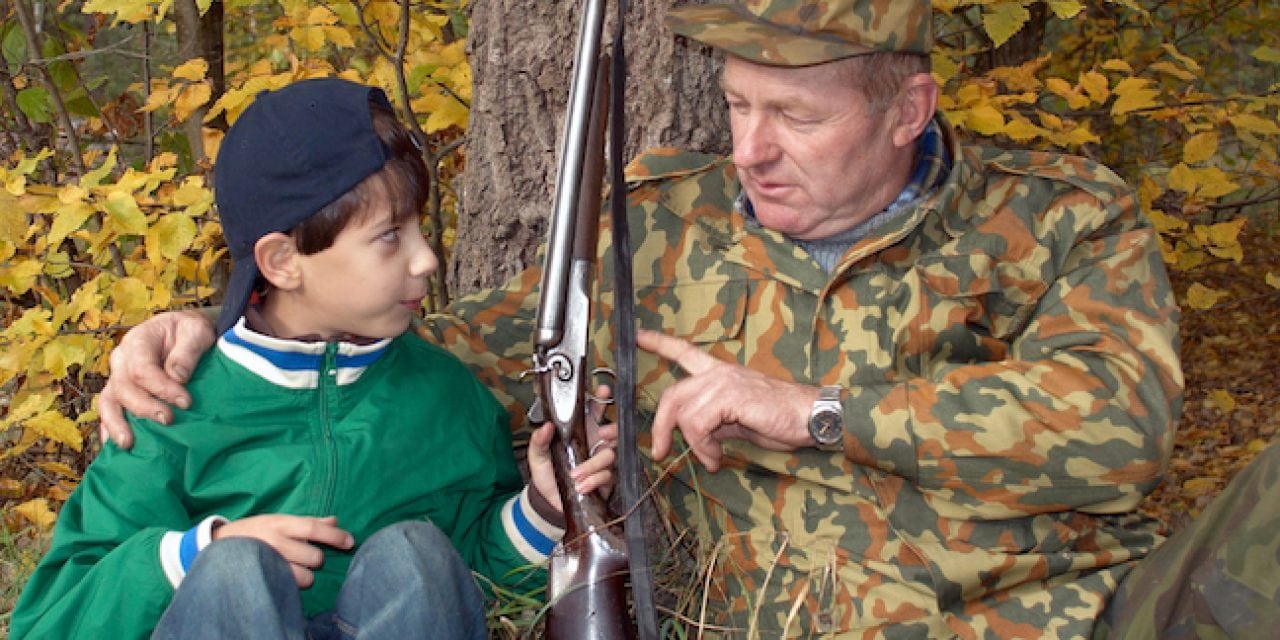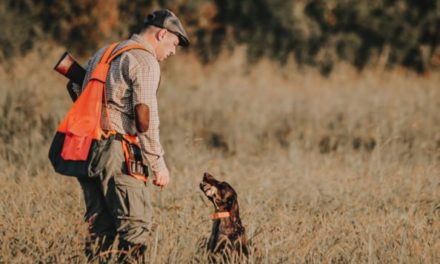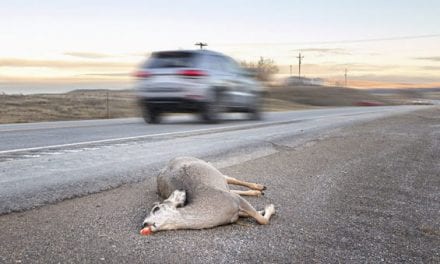Young hunters don’t just pop up out of the ground. They often are carefully nurtured and mentored into the sport.
By Andy Olivera
My 15-year-old son Andrew and I decided at the last minute to go out and catch the final weekend of Texas’ turkey season. It didn’t take much prodding as my son has the same passion for being outdoors and hunting as I do.
We packed the truck quickly and took off to our family hunting property in Bastrop County that we affectionately call the Ranchito.

Take a young hunter with you as often as possible. Answer his questions and explain why certain things are done in a particular way, but avoid putting too much pressure on him. (Shutterstock image)
When we got to the ranch, we did a quick inventory of our necessities; my son had forgotten his hunting boots. The ranch had several pairs of muck boots in all different sizes thrown in a pile on the front porch of the camp house from past outings by my family and friends.
Those castaways consisted of boots that someone had either outgrown, beat up, left for dead, or forgot — but all had good life left in them so we kept them.
My son pulled out a pair of Redwings that I had not seen in a while. They were my old hunting and work boots that I had retired a few years back.
Those boots had been well used and had seen better days. In fact, they had seen numerous great days out in the field. They were pretty beat up with cuts and stains from past adventures and game harvests. The steel toe on the right boot was showing through and both heels, replaced twice before, had been worn almost completely flat.
Those soldiers were lying in wait for my son and his foot to grow to size 13. That was the day they were going back in the field. I watched him pull on those boots with a smile on his face — and one on mine — as I felt the strong tradition of working and hunting outdoors passing through to the next generation.
Hunting in Texas has always been about family and tradition, as my fondest memories take me back to being out in the field at a very early age.
My uncles would take my brother, my cousins, and me hunting and fishing in Atascosa County at a friend’s ranch and we were always willing participants. At the time, I did not realize how much effort in planning, scheduling, luck and money went into every hunting and fishing outing we went on.
The camp, the food, the guns, the light-load bullets, the knives, the fishing poles, the bait, the ice, the clothes, the gas, the boots — and don’t forget to pack the first aid kit! All I knew was that my uncles had taken care of everything and I was a welcome guest.
The first step in getting Texas kids involved in the outdoors is to include them in your outdoor life as much as you possibly can. Here’s what I’ve learned about how you can develop the passion and build a book full of great adventures with your children.
1. LOOSEN UP YOUR EXPECTATIONS AND TURN YOURSELF INTO A HUNTING GUIDE
Even though your kids have heard all your stories and have seen most of the pictures you and your hunting buddies have taken, “their” hunt is going to be different. Kids get bored easily, they’re restless, and they’re noisy.
If a kid loses interest and wants to go home after a few hours of being in the field, you are not doing your job. If young kids don’t have fun the first couple of times they hunt, they won’t want to go back.
Make a game out of identifying birds or trees, and collect leaves, rocks and other items to encourage learning and involvement.
Let them bring along books, crayons, toys or even electronics to provide a bit of entertainment when the action is slow. Let them explore, teach them how to speak softly and answer all their questions. You will be amazed at how many questions they can ask and you just might impress yourself with how many correct answers you have.
Try to keep blind hunts short, maybe an hour, then get up and move. Walking and stalking gets things active and creates excitement. Encourage them to keep their eyes peeled and set up a silent communication game where you only use hand signals to communicate and see how long you can do this without actually talking.
You need to make sure they remember the entire experience as fun and not boring. The more you take them out, the less they will be bored.
2. TEACH CORRECT HUNTER SAFETY FROM THE BEGINNING
Don’t make assumptions that your young hunter knows any safety rules or even any common-sense safety rules. Sometimes you will feel that you are continually repeating yourself about these rules, but don’t let that frustrate you. Be there as a consistent reminder of good safety behavior and that accidents can happen at any time.
When out in the field with your new hunters, make sure you continually remind them that safety is the No. 1 priority.
Safety is not a place where you can lower your expectations. Make sure you instill this aspect of hunting early and often. I still can hear my uncle’s voice loudly advising me to check my muzzle, or to slow down when I was carrying a gun, or to get my finger out of the trigger guard.
In your down time, or while sitting in a blind, challenge your hunters to memorize the Ten Commandments of Firearm Safety. Print it out and hand them a copy. Tell them they have to memorize it before they can go out with you again. Make it a game and have fun with it. When it comes time to take their Texas Hunter Safety course they will thank you. It’s also a great refresher course for you.
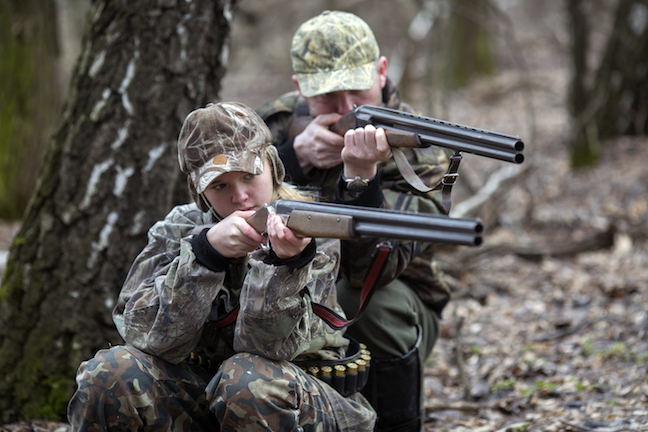
Don’t just put a gun in your kid’s hand on the day of the hunt and expect her to make an appropriate kill shot. (Shutterstock image)
3. BE PREPARED NOT TO “ROUGH IT” TOO MUCH
Taking adequate gear is up to the guide; you should never assume that your young hunter has packed everything for the hunt, even if you have reminded him 10 times already. Remember to bring drinks and snacks for your young hunters.
There is nothing like hearing a kid say, “I’m hungry!” 100 times in a row to remember this tip.
Kids lose any focus and all attention if all they are thinking about is being thirsty or hungry.
On the flip side, remind the youngster to go to the restroom before you go out. But if they do forget and later need to go, don’t embarrass them; let them go outdoors. And let’s hope you remembered to pack a roll of toilet paper — another valuable lesson.
Have your guys dress in several layers, as kids get cold much easier than adults, and don’t forget gloves. Sounds basic, but it’s all necessary. Don’t worry if you forget something as you, or better yet your kids, will remember. They are extremely fast learners too.
4. GIVE YOUR CHILD TIME
While there is no set minimum age for a child to shoot their first animal, it’s up to you to make the call as to when the youth is ready to harvest their first animal. Letting a child shoot a gun or harvest an animal before being mentally or physically equipped can soften that passion for hunting.
Let your child tell you when he or she wants to shoot an animal. If your child does want to try to shoot an animal, then make sure your child is fully capable and consistent with the shot placement. Only range time can develop that confidence.
As consistently delivering kill shots on paper and metal targets develops, so does confidence in harvest time situations.
Don’t just put a gun in your kid’s hand on the day of the hunt and expect him to make an appropriate kill shot.
When hunting with your child and an opportunity to harvest the animal presents itself, be sure and coach the shooter on what you are looking for and be patient. We are looking for a vitals broadside shot at less than 100 yards to begin with, maybe even 50 yards. If it does not present itself we let the animal walk; there is always tomorrow. There is nothing worse than trying to track down a wounded animal, especially if you could have avoided the situation altogether simply by being patient. This is a huge lesson that can frustrate a young hunter, but a necessary lesson to develop correct harvesting habits.
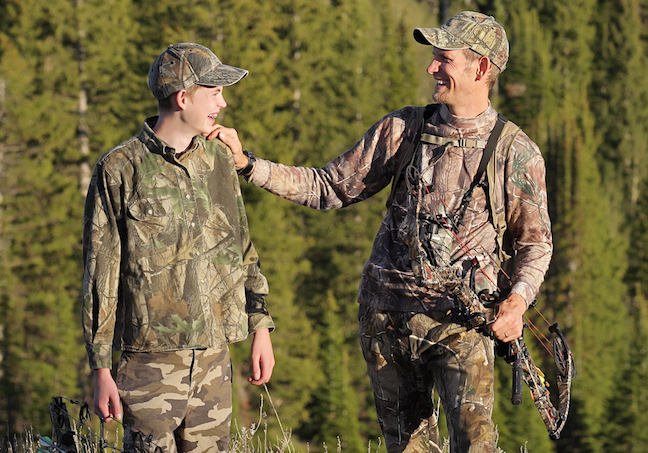
Include your young ones in as many hunting adventures as you can. (Shutterstock image)
5. DON’T PUSH ANYTHING TOO HARD
I go hunting as much as I possibly can and I always ask my kids if they want to go with me on the outings. Sometimes they come and sometimes they don’t.
I never force my kids to go if they don’t want to.
The idea is to show your kids how much you enjoy getting out into Texas’ great outdoors.
Not every child is going to want to go hunting, and that’s OK.
The more someone feels pushed into doing something, the less they will want to do it, and that’s just human nature. You will find that when you come back from going hunting without them that they had changed their minds and wished that they had gone. When they want to go, take them as often as you can.
6. EAT WHAT YOU KILL
My children have been going hunting with me for as long as they have been able to sit in a blind. So as early as 4 or 5 years old, all my children, including my daughter Carmen, have witnessed the shooting of animals.
The key to this for me has been that we always eat what you kill, that we are not hunting just to kill.
If a whitetail comes out and we choose to harvest it, we are prepared to butcher and pack the meat for nourishment. The same goes for a feral hog, turkey, rabbit, dove or squirrel.
Have them help you with the game butchering. Some kids may not want to participate in that at first, but it has been my experience that for some, this is the most fascinating part of the hunting process.
Have your kids put butcher parts into the cooler as you are processing the animal. Be sure and tell them what the parts are and how you plan on preparing for the table. For example, “Here’s the backstrap. After we tenderize and soak it in buttermilk, we are going to make some great chicken-fried steaks out of this.”
And when you actually have that prized backstrap dinner, be sure and announce to everyone at the table that this was backstrap from an animal that the youngster had harvested. This is sure to lead to the story of the actual harvesting of the animal and the adventure that was had that day.
7. STORIES KEEP HUNTING ALIVE
To get those stories you have to get up, get out, and make it happen. Include your young ones in as many hunting adventures as you can.
It is up to you to teach the next generation of hunters and to pass down the traditions we all hold so dear.
G&F article about Hunting
- Whitetail Deer: 4 P’s You Need to Consider
- 7 Early Teal Hunting Hotspots
- Tag Your Bow Buck Early: Here’s What to Do
- Improve Dove Odds With Timing, Practice, Shot Pattern
The post 7 Steps To Sharing Your Passion With Young Hunters appeared first on Game & Fish.

